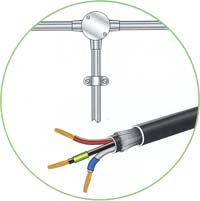In some locations cables can be susceptible to damage by vermin. Damage can occur over considerable lengths of cable where rodents have gnawed away the sheath and insulation, resulting in exposure of the conductors. Where exposed conductors are surrounded by rodents' nesting materials, which are generally combustible, there is a risk of fire. There is also a risk of shock to persons from direct contact with an exposed live conductor. Evidence shows that rodents are not uniquely attracted to one type of cable. All types of cable, for example: thermoplastic (pvc), rubber and lead sheathed cables, seem susceptible to attack.

This article has been extracted from Snags and Solutions Part 2 published by the NICEIC
Solution
Where cables are installed in areas that are, or are liable to be, inhabited by rodents, such as might be found in farm buildings and the roof voids and cellars of certain older properties, the wiring system must be capable of resisting damage caused by gnawing. It is advisable, therefore, to select a wiring system such as one of the following:
- Steel conduit, or trunking
- Mineral-insulated, metal sheathed cables
- Steel-wire armoured cables
- Thermoplastic (pvc) sheathed cables having galvanized steel braid covering
- Steel capping to protect short exposed runs of thermoplastic (pvc) insulated and sheathed cables.
Alternatively, if the use of such wiring systems is impracticable, cables are less likely to be attacked by rodents if they are attached as far up a wall as possible, or, where installed in a roof void, fixed to the underside of the roof structure.
It is worth noting that enclosures of electrical switchgear, accessories and wiring systems (such as trunking), etc should be free of any openings through which rodents could enter and build nests and cause damage to cables.
Manufacturers of cables have said that there is no wholly effective means of prevention, and that if repellents are incorporated in the cable sheath they would almost certainly be toxic and therefore unsuitable for handling in cable factories, and might also be a danger to people handling the finished cable.
Regulation 522.10.1 (Presence of fauna(AL))
Where conditions experienced or expected constitute a hazard (AL2), the wiring system shall be selected accordingly or special protective measures shall be adopted, for example by:
(i) the mechanical characteristics of the wiring system, or
(ii) the location selected, or
(iii) the provision of additional local or general protection against mechanical damage, or
(iv) any combination of the above.
